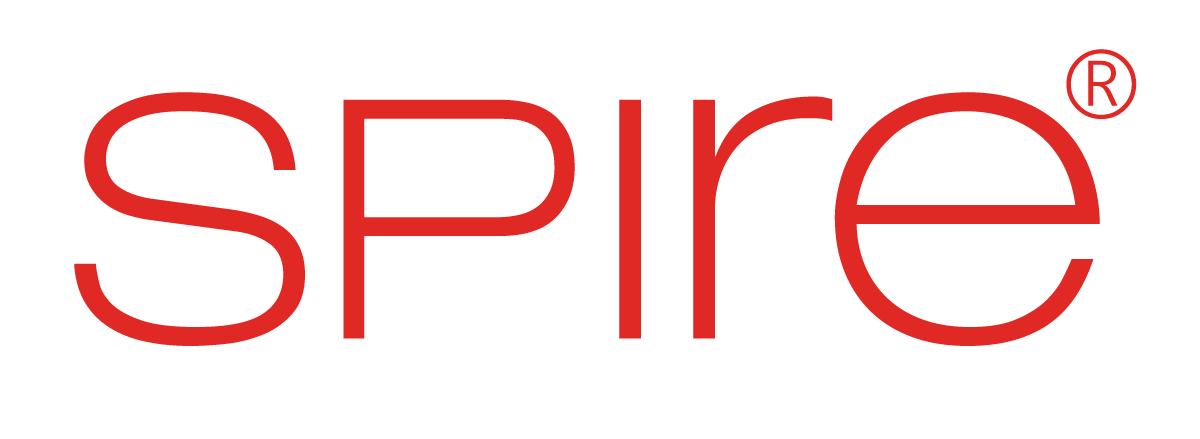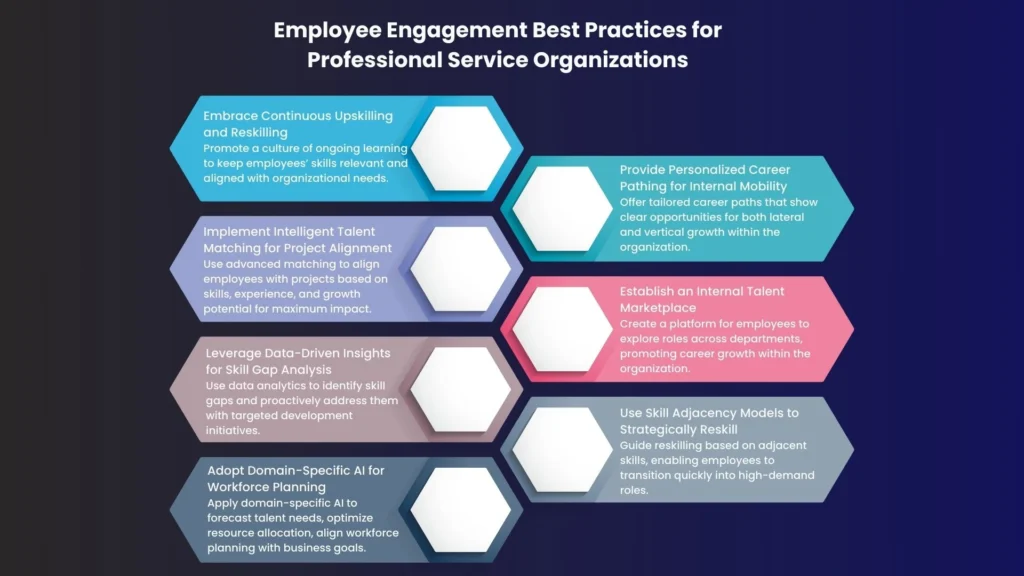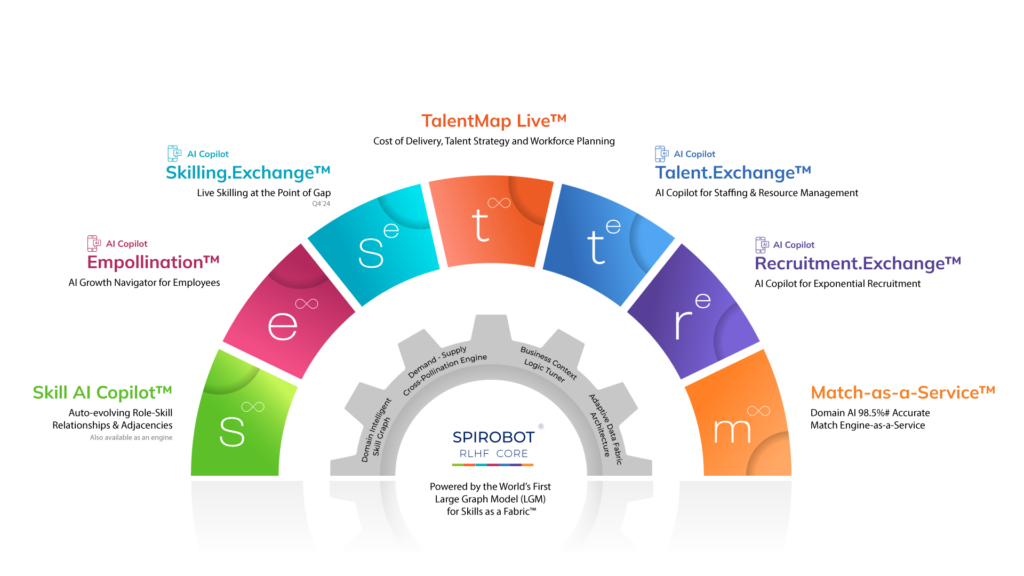This blog explores seven specific engagement practices tailored for PSOs, emphasizing continuous upskilling, structured internal mobility, and intelligent talent matching. By aligning these practices with career pathing, skill adjacency models, and data-driven workforce planning, PSOs can create a resilient and highly engaged workforce capable of meeting evolving client demands.
1. Embrace Continuous Upskilling and Reskilling
To meet changing client demands, PSOs must cultivate a workforce that can adapt quickly. A structured approach to upskilling and reskilling ensures employees can advance within the organization, whether they deepen expertise in their current fields or transition to new roles.
PSOs can offer continuous learning programs aligned with skill gaps identified across the organization. Using intelligent technology to assess these gaps autonomously, PSOs can design specific reskilling pathways that close skill shortages and keep employees engaged and invested in their career progression within the organization. Prioritizing upskilling and reskilling builds a workforce ready to tackle current and future challenges.
2. Provide Personalized Career Pathing for Internal Mobility
For PSOs, where specialized skills are highly valued, a dynamic career pathing that enables internal mobility is crucial. Traditional, rigid career ladders limit growth and lead to turnover; instead, career pathing should support lateral and vertical movement based on employee goals and organizational needs.
PSOs can utilize tools and solutions that highlight skill adjacencies and offer clear pathways for career development across different functions. This approach increases engagement by aligning employees’ career ambitions with the organization’s needs and helps retain talent by presenting viable, achievable, and tailored growth opportunities. Employees who see a future within their company are more likely to stay, primarily when supported with structured internal mobility options.
3. Implement Intelligent Talent Matching for Project Alignment
In PSOs, traditional straight-line matching often involves pairing employees with roles based on a one-dimensional view of skills, focusing on a single set of criteria, such as core skill fit. While this approach can quickly fill roles, it tends to overlook the nuanced capabilities, adjacent skills, and growth potential of employees, leading to missed opportunities for both the organization and its talent.
Intelligent talent matching takes a more holistic and dynamic approach. Unlike straight-line matching, it cross-pollinates all available talent with every demand by evaluating multiple parameters, including skill adjacencies, project requirements, and individual career aspirations. Automated data processing continuously updates the alignment between demand and supply, allowing for real-time responsiveness to changing project needs.
This multidimensional approach ensures employees are matched with roles that fit their primary skills, leverage adjacent competencies, and support their professional growth. Intelligent talent matching reduces bench time and enables purposeful deployment, where employees feel truly engaged and positioned for organizational success.
4. Establish an Internal Talent Marketplace
An internal talent marketplace allows employees to explore new roles within the organization, encouraging career advancement without leaving the company. This approach fosters engagement by giving employees greater control over their career paths and reducing the need for external hiring.
PSOs can implement an internal marketplace that regularly promotes job openings or project assignments based on each employee’s skills and career preferences. Employees can access new opportunities aligned with their skill sets and aspirations by creating a transparent system for internal mobility. This marketplace-driven engagement fosters a more dynamic and satisfied workforce, strengthening internal talent.
5. Leverage Data-Driven Insights for Skill Gap Analysis
In a knowledge-driven industry, actionable insights into employee skills and gaps are invaluable. PSOs can pinpoint development needs and address them proactively by analyzing skill gaps at both individual and organizational levels. This data-driven approach helps ensure that the organization’s talent pool evolves in alignment with its strategic goals.
Data-driven tools enable PSOs to identify areas for improvement and create targeted development plans that align with current roles and future demand. These insights help employees stay engaged as they build skills relevant to their professional growth and the company’s needs, making them feel valued and strategically positioned within the organization.
6. Use Skill Adjacency Models to Strategically Reskill
Skill adjacency models are powerful in PSOs, where specialized skills constantly evolve. By focusing on adjacent skills—competencies related to an employee’s primary expertise—PSOs can offer targeted reskilling that prepares employees for roles that may require new but complementary skills.
For example, a professional with a background in data analytics could benefit from reskilling in machine learning, providing additional value for emerging projects. By using adjacency models to identify and build on existing skills, PSOs can create a resilient workforce capable of meeting future demand. This approach enhances engagement by providing employees with meaningful, tailored reskilling paths aligning with personal and organizational goals.
7. Adopt Domain-Specific AI for Workforce Planning
Domain-specific AI solutions are invaluable in PSOs for managing the unique demands of workforce planning. By analyzing trends, skill availability, and projected needs, domain-specific AI offers insights that guide workforce decisions, ensuring that employees are effectively aligned with future opportunities.
Domain-specific AI can predict skills in demand, allowing PSOs to make informed decisions on which skills to nurture internally through upskilling or reskilling programs. This proactive approach to workforce planning will enable PSOs to accurately match talent with demand, building a relevant internal workforce. As a result, employees feel supported in their growth and strategically aligned with the organization’s long-term vision.
Boosting Employee Engagement: How Spire.AI Intelligent Solutions Drive Growth, Mobility, and Retention
Spire.AI empowers Professional Service Organizations (PSOs) to implement advanced, AI-driven strategies that make employee engagement a dynamic and data-driven process. With its suite of specialized tools, Spire.AI enables PSOs to foster a culture of continuous development, internal mobility, and strategic workforce planning. Here’s a closer look at how Spire.AI solutions drive engagement:
1. Large Graph Model (LGM) for Skills to Uncover Career Growth Opportunities
The Spire.AI Large Graph Model for Skills maps intricate relationships between various skills, roles, and competencies across industries. This allows PSOs to uncover specific growth paths and development opportunities for employees, whether for vertical advancement or lateral skill expansion. By visualizing these personalized career trajectories, Spire.AI helps employees understand how their skills fit within the broader organization, making career advancement more transparent and accessible.
The Spire.AI Large Graph Model for Skills allows PSOs to uncover specific growth paths and development opportunities for employees, whether for vertical advancement or lateral skill expansion.
2. Intelligent Talent Matching with Multi-Algorithm Match (AlgoRator)
The Spire.AI multi-algorithm matching technology, AlgoRator, enhances engagement by matching employees with roles where they are best suited to excel. With a 98.5% match accuracy, AlgoRator factors in skill relevance, experience, and project need to ensure employees are placed in assignments that align with their strengths and career goals. This intelligent alignment leads to higher job satisfaction and performance, creating a workforce where employees feel valued and purposefully deployed.
With a 98.5% match accuracy, AlgoRator factors in skill relevance, experience, and project need to ensure employees are placed in assignments that align with their strengths and career goals.
3. Skill Gap Analysis and Targeted Reskilling with Domain-Intelligent AI
Domain-Intelligent AI continuously evaluates skill gaps within the organization, providing insights into which skills are in demand and where employees could benefit from reskilling. Identifying skill adjacencies enables employees to develop competencies that align closely with their current roles and future opportunities. This proactive approach to skill development keeps employees engaged by equipping them with relevant skills for ongoing career growth.
4. Dynamic Internal Talent Marketplace
The internal talent marketplace is a central platform where employees can explore new roles and projects that align with their skills. This platform promotes internal mobility by giving employees visibility into roles across departments and functions, reducing turnover by enabling career advancement within the organization. This system provides a clear path for progression, fostering engagement through new, relevant opportunities.
5. Real-Time Demand-Supply Matching with Cross-Pollination Technology
Cross-pollination technology dynamically matches employee skills with immediate and forecasted project needs, keeping employees engaged by reducing time on the bench. By continuously updating skill profiles and aligning them with upcoming projects, Spire.AI ensures that employees are quickly deployed to impactful roles, helping PSOs retain a motivated and engaged workforce.
Cross-pollination technology dynamically matches employee skills with immediate and forecasted project needs, keeping employees engaged by reducing time on the bench.
6. Data-Driven Workforce Planning with Business Context Logic (BCL)
Business Context Logic (BCL) allows leaders to integrate domain-specific rules across locations, business units, and client requirements. Using BCL for data-driven workforce planning, PSOs can align employees with strategic business objectives, proactively matching skill sets to anticipated needs. This approach ensures that employees see a clear connection between their roles and the organization’s growth, creating a more engaged, future-ready workforce.
7. Skilling.Exchange™ for Continuous Learning Aligned with Business Needs
Skilling.Exchange™ provides employees with real-time learning opportunities that address immediate skill gaps. Employees can “tag to learn” specific competencies, integrate them into their development plans, and access curated content relevant to their roles. This tool promotes a culture of continuous learning by offering resources that are directly applicable to project needs, allowing employees to see immediate benefits from their upskilling efforts.
Skilling.Exchange™ provides employees with real-time learning opportunities that address immediate skill gaps. Employees can “tag to learn” specific competencies, integrate them into their development plans, and access curated content relevant to their roles.
Conclusion
In today’s skill-driven world, employee engagement in Professional Service Organizations is more than a retention strategy—it catalyzes sustainable growth and adaptability. Engaged employees are not just productive; they’re future-focused, actively contributing to the organization’s long-term success. By empowering talent through internal mobility, personalized learning, and strategic career paths, PSOs can cultivate a resilient and agile workforce in the face of changing market demands.
Spire.AI enables PSOs to transition from traditional, reactive engagement models to a proactive, skill-centric approach that treats employee growth as an ongoing journey. With Spire.AI, organizations don’t just manage talent; they create an ecosystem where individuals thrive, driven by clear pathways, strategic skill development, and intelligent matching. The result? A high-performing, engaged workforce that’s not just aligned with current projects but ready to shape the organization’s future.







